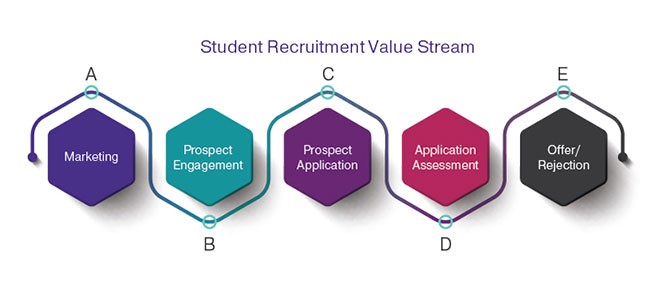Digital Transformation: Where do you start?

Key takeaways
- The process of digital transformation can be overwhelming, but we’ve got to start somewhere
- A ‘standard’ approach to transformation might not necessarily be the right approach
- Common themes amongst other digital transformation disruptors: Putting customer experience front and centre
This year I attended the EUNIS Congress, organised annually by the European University Information Systems Organisation and hosted in the picturesque city of Trondheim, Norway. The tagline for the event was ‘Campus For The Future’, with presentations ranging from the futuristic design of campus buildings (real and virtual), to the use of advanced technologies in the delivery of teaching, learning and research.
Speaker after speaker advanced their visions of the future, and all presenters (well, all the ones I saw) used the same two words to describe the method of transportation to these golden lands of Valhalla (Norway, see what I did there?): digital transformation.
Now, this statement will not come as a surprise to anyone who has attended any variance of an IT conference in the last 12 months—digital transformation is our new General Data Protection Regulation (GDPR) and blockchain. However, unlike its ‘hot topic’ predecessors, digital transformation can feel somewhat less tangible.
While the visions presented at the conference were often based on competent research and expectations shared by the audience, much of the post-speech common room chatter centred on the potential enormity of taking an organisation through a process of digital transformation.
For the most part I agree. There is much to do and the process can appear overwhelming but as the saying goes, the first thing to recognise is ‘you can’t eat an elephant in one bite’. This is particularly pertinent in terms of resource. All organisations have a fixed amount of capital, talent and (let’s be honest) energy to spend on all things innovative but you have got to start somewhere.
In my opinion (humble) the starting point is clear and visible from both the global higher education sector’s current environment as well as the perspectives of those who have trodden this path before. The entire sector is increasingly being marketised and the need to attract and support our higher education customers (deliberate wording) will be core to growth and survival.
So how did other sectors achieve this transformation?
Well, I’d suggest that those starting with a focus on customer experience will probably do best.
Two-thirds of the CEOs of (2000) Global companies will shift their focus from traditional, offline strategies to more modern digital strategies focused on the customer experience before the end of 2019.
IDC, "The Digital Transformation of the World"
If you look at notable disruptors such as Amazon, Spotify and Uber, they all came to market in a relative short period of time and became the leaders in their field. There is a simple, common element between all three: While they didn’t invent books or music purchasing or the concept of the taxi, what they did revolutionise was the attaining of these services. This was mainly achieved by offering simple customer convenience i.e. putting the customer front and centre.
Let’s consider a key process for universities—student recruitment. Essentially, this is a value chain that has several key elements as shown in the diagram.

If we park ‘Offer/Rejection’ to one side for now, the two elements ‘Prospect Engagement’ and ‘Prospect Application’ are the main customer interaction points within the value stream. It doesn’t matter how impressive and well-constructed the other elements are, if customers fail to engage at these points then the business is at risk.
Let me go back to the earlier example of Amazon. Most people would say that the main reason they use Amazon is for the ease and convenience. When making a purchase, how many people say to themselves, ‘I hope their internal processes are effective and efficient’—nobody (unless maybe you’re a business analyst).
We are all honestly only concerned with the fact that the customer interface is straightforward to navigate, products are easy to find, integrated payment methods are seamless and the goods (mostly) arrive when they should. This is why Amazon was responsible for 49 percent of all eCommerce in the US in 2018, according to data from eMarketer.
Business assessment artefacts like capability models and process maps exist to help institutions identify the main components to deliver the value stream, including what data sets are required, which individuals and applications are involved and so on. This then helps highlight the key metrics to ensure that expected outcomes are on track.
However, while identifying critical customer interaction points may be easy, here’s a word of warning. A ‘standard’ approach to transformation might not necessarily be the right approach.
In the student recruitment example cited earlier, ‘Prospect Engagement’ may need to have a more ‘warm and fuzzy’ consideration allowing for human engagement to assist guiding (particularly younger) prospects through higher education selection. For the more administrative function of ‘Prospect Application’, research suggests that these types of interactions need to be quick and easy to use to prevent the customer from having time to reconsider their options.
To summarise, digital transformation is not easy. It’s a voyage and the question is: Do you agree on the boarding point?
Many institutions will have begun thinking about or are putting in place their plans for transformation and how they will adapt to the digital era. At Ellucian, we understand the need for, and advantages of, digital transformation within a higher education context to deliver a seamless customer experience—supported by business efficiency—that is also scalable and adaptable to rapidly changing market demands.
As an enterprise architect, I believe the use of enterprise architecture plays a key role in this process by constructing and visualising strategic and business artefacts that align to our application and technology portfolio, ensuring the continued success of our higher education customers. Don’t hesitate to get in touch and learn more about our approach.
Follow our higher ed conversation on Twitter, LinkedIn and Facebook.
Learn more about our Digital Transformation Series.

